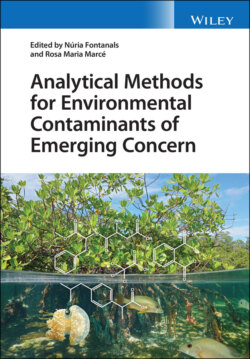Читать книгу Analytical Methods for Environmental Contaminants of Emerging Concern - Группа авторов - Страница 35
2.2.2 Water Samples
ОглавлениеThe high polarity of pharmaceuticals makes it unsuitable to use the standard liquid-liquid extraction technique. Furthermore, this technique is not environmentally friendly. Therefore, for the extraction of pharmaceuticals from aqueous samples the SPE technique is the most widely used. This technique allows for the simultaneous extraction of analytes from various groups and the clean-up of the sample with a high concentration factor and the low consumption of organic solvents. However, it should be mentioned that for SPE the water samples should be filtered, and it is recommended to adjust pH to accelerate the analytes adsorption. Filtration removes the fraction of target compounds adsorbed in suspended particles, and it is therefore recommended to wash the filters with methanol [51]. The extraction of pharmaceuticals from water requires a high volume of samples due to the low concentration of targets (at the level of a few ng/L of water) [33, 52] and a concentration factor higher than 1000. This means that with the extract volume equal to 1 mL, the volume of the tested water sample should be as much as 1000 mL, which is recommended for using the EPA Method 1694 (December 2007, EPA-821-R-08-002) [53–55]. In addition, with reference to the review by Białk-Bielińska et al. [33], the average volume of water sample that can be passed through the standards SPE column without significant loss of extraction rate and efficiency is 100–200 mL. This seems to be insufficient, especially for drinking water characterized by a particularly low level of pharmaceutical concentrations. To solve this problem, the commonly used SPE technique can also be performed with the use of speed extraction disks, which are characterized by a quick extraction of samples with a large volume: 80–90 mL per minute for volumes up to 2 L. According to literature reports, speedisks were used in the monitoring of pharmaceuticals in drinking water, rivers, seawater and groundwater [52, 56–59]. As already mentioned in subsection 2.2, another approach to the extraction of pharmaceuticals is passive extraction, where the sampling process is carried out simultaneously with the extraction of analytes [26, 32, 60]. Furthermore, in addition to classical sample preparation techniques, alternative solutions are increasingly being used. One of these is dSPE, whereby a solid sorbent is added directly to a liquid sample which greatly facilitates contact between the analyte and the sorbent surface. The use of dSPE makes it possible to significantly shorten the extraction time, reduce the amount of sorbent used and simplify the whole process. The extraction efficiency is also higher compared to conventional methods because the interaction between sorbent and analyte is facilitated. Various sorbents including modified and unmodified carbon nanotubes were used in dSPE for extraction of sulfonamides, β-blockers and a mixture of pharmaceuticals and their metabolites [29, 61–64]. The solid-phase microextraction [65], stir bar sorptive extraction [66] or aqueous two-phase systems [67] were also tested for pharmaceuticals.
Table 2.2 Exemplary extraction/clean-up procedures used in the analysis of pharmaceuticals in soil matrices.
| Therapeutic class | Sample pre-treatment | Extraction and extract clean-up | Analytical method MQL/MDL [ng g−1] | Recovery [%] | Ref | |
| Veterinary antibiotics and hormones | Homogenization and sieving | extraction solvent 5 mL MeOH:ACN:0.1 M EDTA:McIlvaine buffer (pH 4): 30 : 20:25 : 25, v/v/v/v/)3 × UAE (10 minutes)20 mL of supernatant diluted by H2O to 500 mLAdjustment to pH 2.3 and filtrationSPE (Oasis HLB column) | LC-MS/MS2–10/0.5–3 | 72–121 | [112] | |
| Quinolone antibiotics | Air-drying, sieving | extraction solvent 5 mL 50% Mg(NO3)2 in 4% aq. ammonia3 × UAE [10 minutes]SPE (Oasis HLB column) | LC-MS/MS0.004–0.011/0.001/0.003 | 67–88 | [113] | |
| Veterinary antianxiety medications | Air-drying, sieving | extraction solvent 2 mL H2O, 2 mL 2 M aq. NaOH, 10 mL EtOAcUAE (15 minutes)Supernatant (5 mL) dried under N2 (50°C)Dissolving in 1 mL MeOHVortex with 1 mL 1% aq. FA (pH 3.5)LLE with 0.5 mL n-hexane | LC-HRMSNo data | 58.9–102.6 | [114] | |
| 4 analytes including diclofenac and naproxen | Air-drying, sieving | 2 × LLE using phosphate buffer (pH 2): MeOH (3 : 4, v/v) (shaking 260 rpm 60 minutes)LLE using 20 mL MeOH (shaking 260 rpm 60 minutes)Supernatant mixed with 1200 mL deionized waterSPE (Oasis HLB column) | No data | 61.7–74.5 | [115] | |
| 15 analytes including NSAIDs, lipid regulators, antiepileptics, β-blockers, antidepressants | Air-drying, sieving | STEP 1 Anhydration with Na2SO4 (60 minutes)8 mL ACN (2% NH4OH)UAE (15 minutes)Solvent evaporation and collection in graduated tubesSamples washed with 1 mL of ACN (2% NH4OH)Extracts evaporated to dryness | STEP 2 UAE (15 minutes) with 8 mL ACN (2% of formic acid)Sampled washing with acidic solventExtracts collected to graduated tubes from Step 1Evaporation to dryness and reconstitution to 1 mL with ACN | GC-MS0.14–0.65/0.07–0.53 | 40.8–112.8 | [48] |
| NSAIDs, Oestrogenic hormones | Air-drying, sieving | 10 mL H2O (pH 2) and 10 mL ACNAddition of anhydrous MgSO4 (4 g) and Na2SO4 (1 g)Vortex 1 minutesMAE (23 minutes)Organic layer evaporation to dryness (N2)Dissolved in 100 mL H2O (pH 2)SPE (Oasis HLB column) | GC-MS0.9–17.1/0.3–5.7 | 38.7–108.2 | [49] | |
| 11 Analytes including 6 hormones | Freeze-drying, homogenization | 10 mL acetone:n-hexane (70 : 30, v/v) solvent mixture using an ice bath, IS additionFUSLE sonication (5 minutes)Evaporation and extract reconstruction in ACNdSPE (Envi-carb protocol) | LC-MS/MS/1–3.2 | 5–30 | [116] | |
| Veterinary antibiotics | Freeze-drying, homogenization | Surrogates and 0.1 g of NaF addition (as ion exchanger)extraction solvent 5 mL MeOH:EDTA:citrate buffer (3 : 2 : 1, v/v/v)3 × UAE (15 minutes)Combined supernatant degreased by n-hexaneDilution to 250 mL with sterilized waterFiltration and adjustment to pH 4Tandem SPE (SAX plus HLB columns) | UPLC-MS/MS No data | 47.3–90.0 | [117] |
